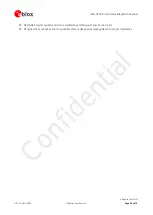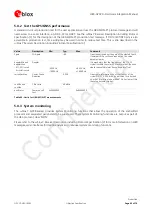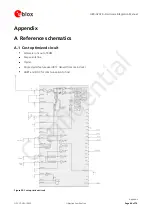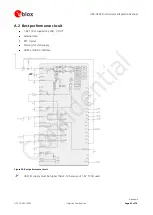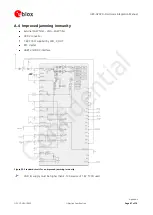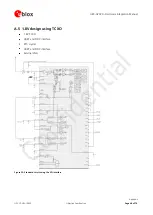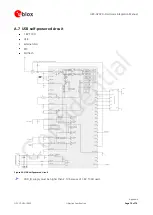
UBX-G7020 - Hardware Integration Manual
Production
GPS.G7-HW-10003
Objective Specification
Page 63 of 74
5.4.2
Test the GPS/GNSS performance
A standard in-circuit production test for the user application will use the UBX-MON-PT protocol message and will
need access to a serial interface, e.g. DDC, SPI or UART. See the
u-blox 7 Receiver Description including Protocol
Specification
[3] for the description of the UBX-MON-PT production test message. If PIO13 (EXTINT0 pin) is also
accessible in production test, time aiding may be used in order to reduce test time. This is also described in the
u-blox 7 Receiver Description including Protocol Specification
Value
Description
Min.
Typ.
Max.
Comments
Pgain
PGA gain
~80
Gives indication about the gain of the whole RF path.
If external LNA or active antenna used, the value
becomes lower.
dopplerMin and
dopplerMax
- if TCXO is used
- if crystal is used
Doppler
- 4000 Hz
- 19000 Hz
+ 4000 Hz
+ 19000 Hz
It is mandatory that the frequency of the TCXO/
crystal is within these limits. Make sure that the used
single channel simulator has no doppler offset.
carrphDevMax
Carrier Phase
Deviation
0.004
Gives some information about the stability of the
crystal/TCXO. 0.004 is the typical value for a tracked
SV with C/No ratio of about 40dB*Hz. For lower C/No
the value becomes higher.
cnoMin and
cnoMax
C/No ratio
40 dBHz
postStatus
Power on self
test
0x00000000
0x00000000
Table 39: Limits for UBX-MON-PT measurements
5.4.3
System monitoring
The u-blox
-
7 GPS Receiver provides System Monitoring functions that allow the operation of the embedded
processor and associated peripherals to be supervised. These System Monitoring functions are output as part of
the UBX protocol, class ‘MON’.
Please refer to the
u-blox 7 Receiver Description including Protocol Specification
for more information on UBX
messages, serial interfaces for design analysis and individual system monitoring functions.
Confidential











